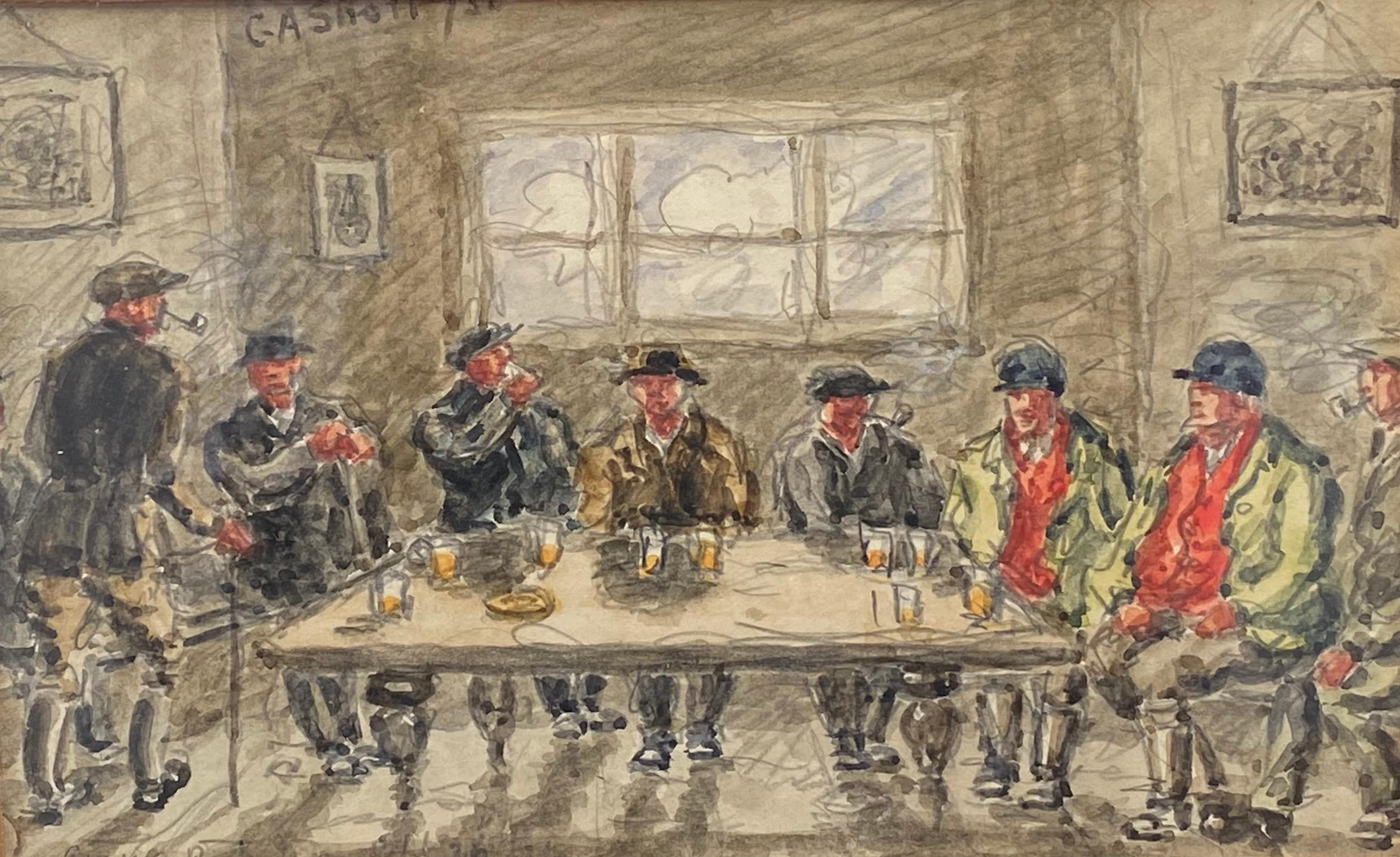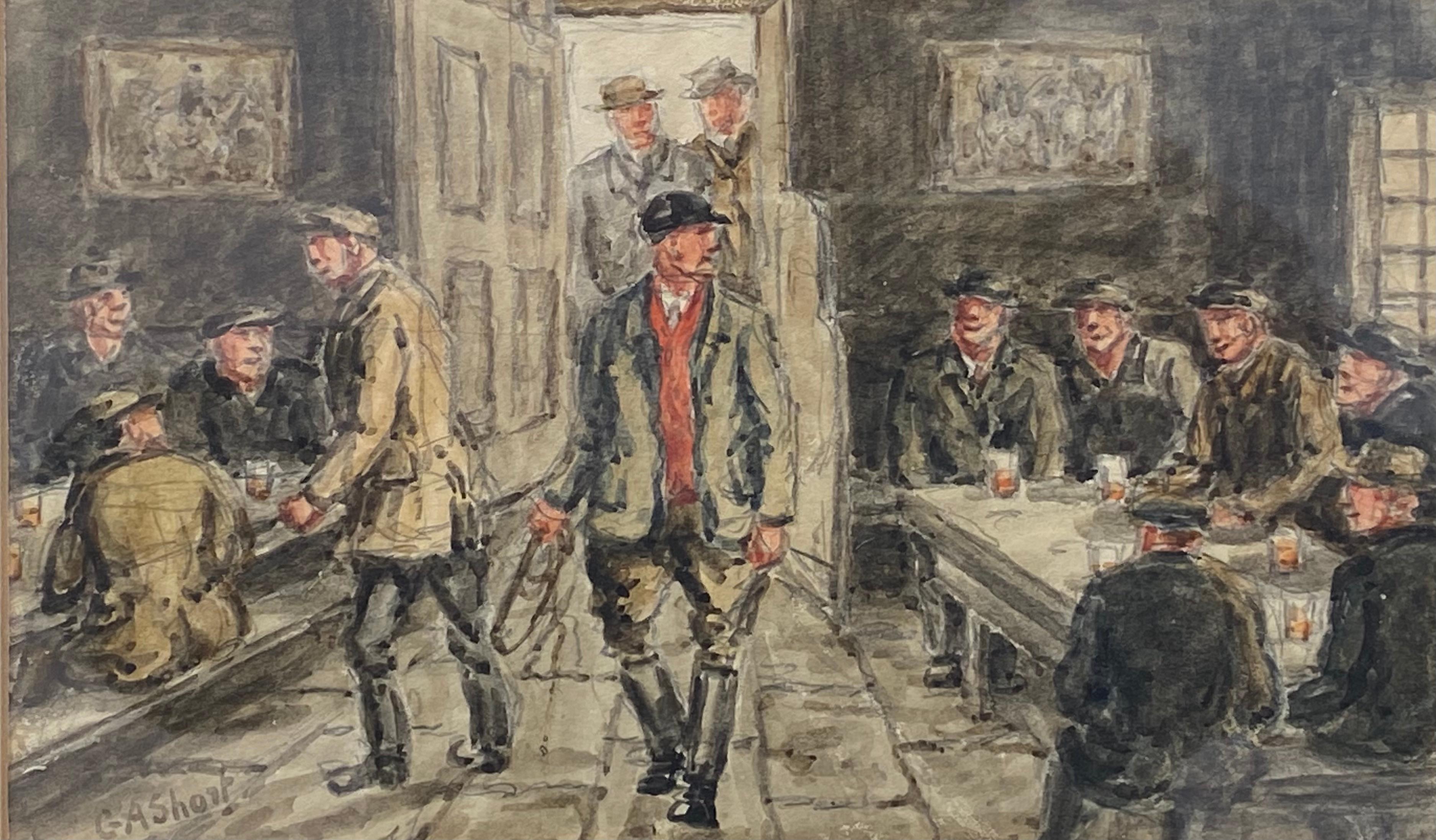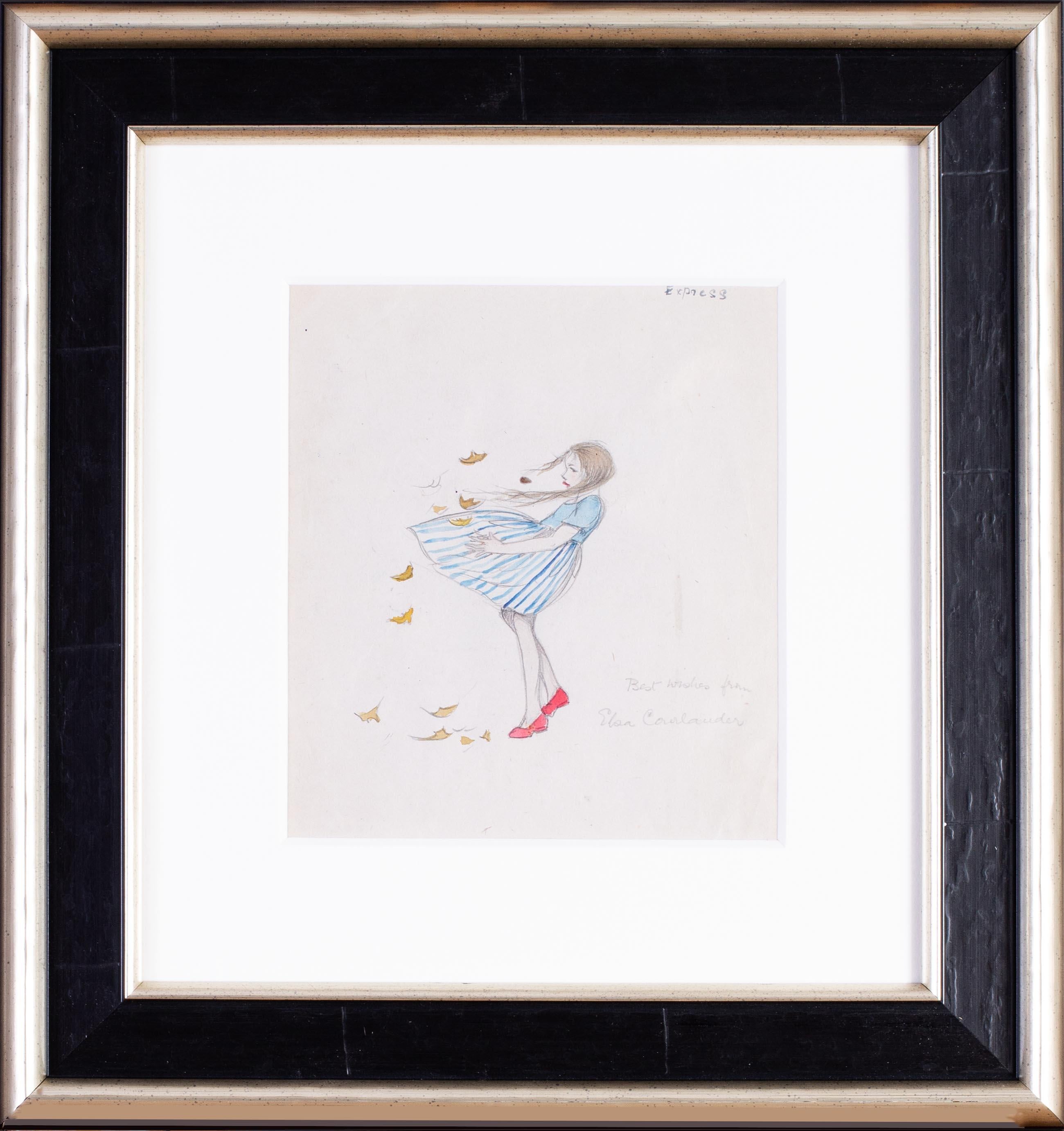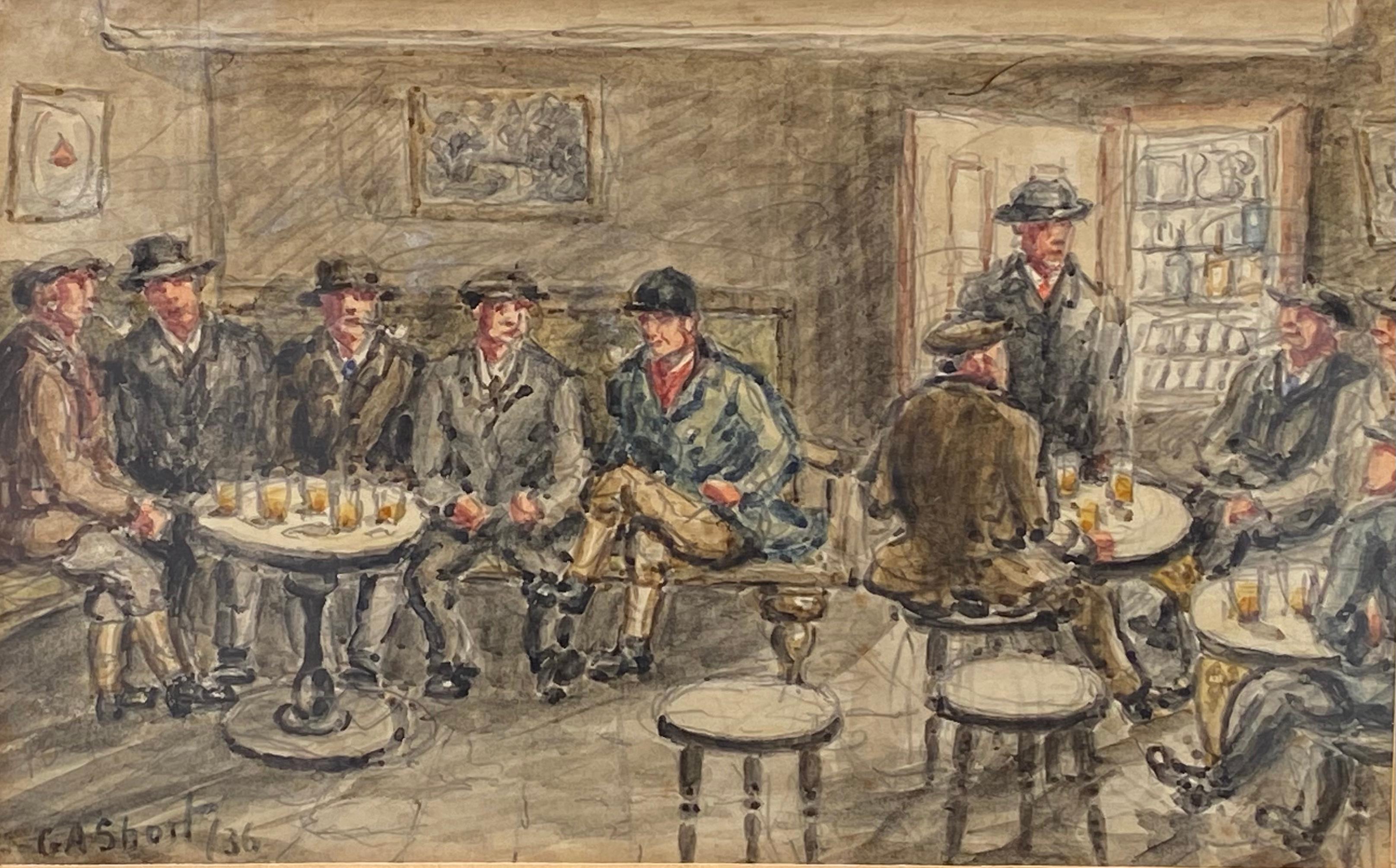Items Similar to The Buttonhole By Charles Spencelayh
Want more images or videos?
Request additional images or videos from the seller
1 of 9
Charles SpencelayhThe Buttonhole By Charles SpencelayhCirca 1940
Circa 1940
About the Item
Charles Spencelayh
1865-1958 British
The Buttonhole
Signed “C.SPENCELAYH” (lower left) and inscribed “This Drawing was accepted into the Royal Academy but crowded out for want of space” (en verso)
Watercolor and pencil with gum arabic on paper
One of the most important English genre painters in the Academic style, Charles Spencelayh's anecdotal scenes are among the best of his age. This work, entitled The Buttonhole, captures the celebrated painter’s preferred subject – an elderly gentleman performing an ordinary task. Spencelayh’s talent for portraying the common man with an engaging sentimentality remains unsurpassed, and his everyday narratives imbue his work with an undeniable timelessness.
He trained at the National Art Training School (later renamed the Royal College of Art), where he flourished in his figural drawings. Spencelayh continued his education in Paris, where he exhibited at the Salon with much success. His primary exhibition venue throughout his career was the Royal Academy, where he showcased 30 paintings from 1912 to 1958. His incredible canvases were hung in the leading art venues of the day and gained him membership into the most prestigious art societies.
During his lifetime, Spencelayh was greatly admired by many influential collectors, including Queen Mary, who provided the artist and his family a residence in Manchester. Spencelayh painted a postage-size portrait of King George V for the Queen’s dollhouse that currently resides in Windsor Castle. Today, his work is highly sought after, though examples rarely become available on the market.
Circa 1940
Paper: 15 1/2" high x 11 3/4"
Frame: 26 1/2" high x 22 5/8" wide
Provenance:
Charles Nicholls & Son, Manchester
Sotheby’s, Chester, 27th April 1989
Private collection, United Kingdom
M.S. Rau, New Orleans
- Creator:Charles Spencelayh (1865-1958, British)
- Creation Year:Circa 1940
- Dimensions:Height: 26.5 in (67.31 cm)Width: 22.63 in (57.49 cm)Depth: 1.38 in (3.51 cm)
- Medium:
- Movement & Style:
- Period:
- Condition:
- Gallery Location:New Orleans, LA
- Reference Number:
About the Seller
5.0
Vetted Seller
These experienced sellers undergo a comprehensive evaluation by our team of in-house experts.
Established in 1912
1stDibs seller since 2013
13 sales on 1stDibs
Typical response time: 4 hours
- ShippingRetrieving quote...Ships From: New Orleans, LA
- Return PolicyThis item cannot be returned.
More From This SellerView All
- La femme préhistorique (Prehistoric Woman)By James Jacques Joseph TissotLocated in New Orleans, LAJames Tissot was among the most successful and critically acclaimed artists of the Victorian era. Although the artist is celebrated for his elegant scenes of fashionable life in Paris and London, this work is a fascinating rarity within his oeuvre. In this monumental pastel, Tissot depicts a prehistoric woman draped in a tiger skin, presented with a striking pose and heroic air. His delicate portraiture, combined with his fascination with conveying texture, demonstrates why he was one of the most revered artists of his generation, and La femme préhistorique illustrates the remarkable technique for which he was renowned. This work was completed in preparation for a series of works exploring the Old Testament undertaken by Tissot from 1899-1902 that remained unfinished at the time of his death. A portion of this series focused on illustrations of Adam and Eve, and among these sketches were images of a nude Eve partially draped in animal furs. Towards the end of his life, following his conversion to Catholicism, biblical subjects became important to the artist. A few years before this work was completed, Tissot embarked upon a highly ambitious group of nearly 300 watercolors illustrating the New Testament, presenting the illustrated epic in its entirety at the Paris Salon of 1894. Both of these series were a critical artistic departure for the artist, stemming from a desire to create works separated from his typical images of modern society. This pastel imagines Eve as the prototype of womanhood in the guise of a prehistoric woman. Tissot rarely painted the nude, and his skill as a draftsman highlights the figure's natural beauty, contrasting it with the stark landscape surrounding her. Although a study, this monumental work is incredibly well-finished and highly engaging, with the statuesque model commanding the majority of the canvas. Her pose is strong and theatrical, and she addresses the viewer with a direct, confident gaze. The imagined historical subject of this drawing is grounded by Tissot’s exceptional attention to detail. A master of conjuring an array of textures, Tissot showcased this ability in this work by juxtaposing many types of fabrics and natural elements within one composition. The tiger skin with which the woman partially covers herself was a favorite studio prop of Tissot’s, appearing in many of his most influential works from the period, including several paintings of his partner and favorite model Kathleen Newton. It, in particular, showcases the artist’s understanding of texture, yet it also serves as an exotic element that elevates the sensuality of the scene when placed against the woman’s bare skin. Born in 1836 in the port town of Nantes, Tissot traveled to Paris at the age of 20 in order to join the studios of Hippolyte Flandrin and Louis Lamothe. During this period, he became close with James Abbott McNeill Whistler, Edgar Degas and Edouard Manet, and the impact of these friendships is reflected in his portraits of modern life. Having enjoyed considerable success in Paris during the 1860s, Tissot fought in the Siege of Paris, and after the fall of the Commune in 1871, he went to London, where he stayed for the next ten years. He was met with incredible success there, and he also met the love of his life, Kathleen Newton, a divorcée, with whom he lived from about 1876 until her death in 1882. Today he is regarded among the great masters of Belle Époque painting, and his works can be found in important collections worldwide, including the Metropolitan Museum of Art, the Brooklyn Museum, the National Gallery of Art, the Musée d’Orsay, the Tate Gallery and many others. This pastel remained in Tissot's private collection until his death in 1902 and is referenced in the posthumous 1902-3 valuation of Tissot's home at 64 avenue du Bois...Category
Early 20th Century Academic Nude Drawings and Watercolors
MaterialsLaid Paper, Canvas, Oil Pastel, Pastel
- Piccadilly Circus by Fortunino MataniaBy Fortunino MataniaLocated in New Orleans, LAFortunino Matania 1881-1963 Italian Piccadilly Circus Signed “Matania” (center, on bus) Watercolor and gouache on paper This exceptional watercolor and gouache composition by fam...Category
Early 20th Century Figurative Drawings and Watercolors
MaterialsPaper, Watercolor, Gouache
- Costume Oriental by ErtéBy Erte - Romain de TirtoffLocated in New Orleans, LAErté (Romain de Tirtoff) 1892-1990 | Russian-French Costume Oriental Signed “Erté”(lower right) Inscribed "No. 19" (en verso) Gouache on paper Titled Costume Oriental, this ensemble epitomizes Erté's signature fusion of Eastern and Western aesthetic elements. The attire features grey pantaloons enveloped by a vivid red skirt adorned with intricate white Orientalist motifs. The bodice, a geometric tapestry of black and white stripes, is composed of narrow horizontal black bands juxtaposed with glittering gemstones. This visual harmony is accentuated by a trio of diamond shapes vertically aligned on the chest. The crowning element is a gem-encrusted turban, surmounted by three red fan shapes, lending the headpiece the appearance of a striking medallion. This sartorial masterpiece is an authentic Erté creation for the 1926 rendition of George White's Scandals, staged at the Heilig Theatre in Portland, Oregon. The revue initially debuted at the Apollo Theatre in New York City on June 30, 1924, enjoying a run of 196 performances before embarking on a tour. Orchestrated by George White from 1919 to 1939, the Scandals series distinguished itself through its timely comedy and exceptional choreography, a testament to White's expertise as a dancer. In contrast to the more lavish Ziegfeld Follies,Scandals offered a streamlined yet sophisticated experience. The Sixth Edition was particularly remarkable for its artistic collaborations: Erté designed the scenery and curtains, while George Gershwin composed the musical score, which included the classic "Somebody Loves Me." The production featured an ensemble of notable performers, including Nyra Brown and the Leeland Sisters. The artist, Russian-French visionary Romain de Tirtoff (1892-1990), popularly known as Erté, began his artistic journey in the culturally rich city of St. Petersburg, where he developed an early fondness for ballet and theatrical performances. He moved to Paris in 1912 to study architecture, and quickly found his creative niche in crafting fantastical costumes for the city’s bustling nightlife. Erté‘s expertise, refined under the guidance of the famed Paul Poiret, captured the attention of Harper’s Bazaar, marking the beginning of a significant partnership that spanned from 1915 to 1936. The artist also designed sets for notable cinematic masterpieces including Ben Hur and La Bohème, and created sets and costumes for cabarets, operas and other performances at the Folies-Bergères, Bal Tabarin, the Théâtre du Bataclan and Le Casino de Paris. Often remembered as the “Father of Art Deco,” Erté was a trailblazer whose colorful creations shaped the groundbreaking Art Deco era more than any other, leaving an indelible mark on the history of art and design. His artworks reside in prestigious museum collections worldwide, including the Metropolitan Museum of Art in New York, the Victoria & Albert Museum in London and the Los Angeles County Museum of Art. Painted 1926 Paper: 12“ high x 9 wide Frame: 19 1/4“ high x 16 1/8” wide x 5/8" deep Exhibitions: M.S. Rau, New Orleans, Erté and the Era of Art Deco, October 14, 2023 - January 3, 2024 Provenance: Private collection, Paris Christie's South Kensington: Sale, 2014 Bouret Gonzalez Collection Sydney and Sibyl Colefax...Category
20th Century Art Deco Figurative Drawings and Watercolors
MaterialsPaper, Gouache
- Salade de Fleurs de Lotus by ErtéBy Erte - Romain de TirtoffLocated in New Orleans, LAErté (Romain de Tirtoff) 1892-1990 | Russian-French Salade de fleurs de lotus (Lotus Flower Salad) Inscribed “n°1.497” (en verso) Gouache on paper In 1929, Erté embarked on the cr...Category
20th Century Art Deco Figurative Drawings and Watercolors
MaterialsPaper, Gouache
- Mistinguett by ErtéBy Erte - Romain de TirtoffLocated in New Orleans, LAErté (Romain de Tirtoff) 1892-1990 Russian-French Mistinguett Signed "Erté" (lower right) Stamped "Composition originale" (en verso) Gouache on paper Erté designed this costume fo...Category
20th Century Art Deco Figurative Drawings and Watercolors
MaterialsPaper, Gouache
- Le roi de Lahore by ErtéBy ErtéLocated in New Orleans, LAErté (Romain de Tirtoff) 1892-1990 | Russian-French Le roi de Lahore (The King of Lahore) Signed “Erté” (lower right) Inscribed "Les Rois des Légendes / No. 11 / Le Roi de Lahore /...Category
20th Century Art Deco Figurative Drawings and Watercolors
MaterialsPaper, Ink, Gouache
You May Also Like
- “British Pub 2”Located in Southampton, NYOriginal watercolor with graphite tracings of interior crowded pub scene by the British artist, George Anderson Short. Signed top left and dated ...Category
1930s Academic Figurative Drawings and Watercolors
MaterialsArchival Paper, Watercolor, Graphite
- “After the Hunt”Located in Southampton, NYOriginal watercolor with graphite tracings of interior pub scene by the British artist, George Anderson Short. Signed bottom left. Circa 1940. ...Category
1940s Academic Figurative Drawings and Watercolors
MaterialsArchival Paper, Watercolor, Graphite
- “Villagers”Located in Southampton, NYOriginal watercolor with graphite tracings by the well known German artist, Peter Von Halm. Signed in pencil lower right. Condition is good. Several tiny foxing spots with small areas of mild wrinkles on the outer corners. Matted but not framed. He was the son of an innkeeper and brewer. Initially, he wanted to become an architect and, in pursuit of that goal, attended the Technische Universität Darmstadt. After 1875, he studied copper engraving with Johann Leonhard Raab and general art subjects with Ludwig von Löfftz, at the Munich Academy. From 1883 to 1885, he lived in Berlin at the invitation of his friend, Karl Stauffer-Bern, where he created graphic versions of the Old Masters for Wilhelm von Bode...Category
1880s Academic Figurative Drawings and Watercolors
MaterialsArchival Paper, Watercolor, Graphite
- Set of six 19th Century studies or Turkish characters by Maltese artist PreziosiLocated in Petworth, West SussexCount Amadeo Preziosi (Maltese, 1816 – 1882) A set of six pencil and watercolour studies or Turkish characters including street vendors, a Turkish sold...Category
19th Century Academic Figurative Drawings and Watercolors
MaterialsPaper, Watercolor, Pencil
- A 1930s drawing of a young girl in a blustery windy day with autumn leavesLocated in Petworth, West SussexElsa Carlander (British, circa 1930) An autumn gust Watercolour and pencil on paper Signed and inscribed ‘Best wishes from Elsa Carlander’ (lower right) 6.5/8 x 5.7/8 in. (16.8 x 15 ...Category
1930s Academic Figurative Drawings and Watercolors
MaterialsPaper, Watercolor, Pencil
- “British Pub”Located in Southampton, NYOriginal watercolor with graphite tracings of interior crowded pub scene by the British artist, George Anderson Short. Signed lower left and date...Category
1930s Academic Figurative Drawings and Watercolors
MaterialsArchival Paper, Watercolor, Graphite
Recently Viewed
View AllMore Ways To Browse
Vintage Dollhouse
Sada Yacco
Sam Savitt
Jean Duplessis Bertaux On Sale
Johannes Volckamer
Amanda Watt On Sale
Everett Shinn On Sale
Felix Russman
Frank Dobson On Sale
George Demont Otis On Sale
Helen Sewell Rennie On Sale
Hendrick V. Tavernier On Sale
Henry Reuterdahl
J Boucher Watercolor
Jean Corniche
Jean Pons On Sale
Julius Frick
Kirk Mangus On Sale





